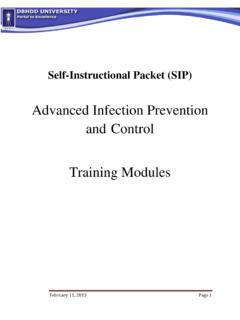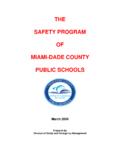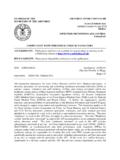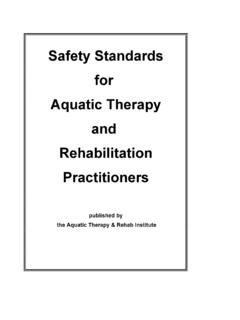Transcription of Infection Control Modules - DBHDD University
1 February 11, 2013 Page 1 Self-Instructional Packet (SIP) Advanced Infection Preventionand Control Training module 2 The Chain of InfectionFebruary 11, 2013 Page 2 Learning Objectives module One Introduction to Infection Prevention and Control After completing module One, the learner will be able to: 1. Explain the role of Infection Prevention and Control in DBHDD Define the term pathogen and explain what constitutes an Define the term healthcare associated Infection (HAI) and explain the difference betweenthese and community associated infections (CAIs).4. Explain the potential impact on hospitalized individuals and hospital employees whocontract healthcare associated Define the term colonization and explain the difference between colonization and Define the term asymptomatic Infection and list two examples of pathogens that can result inasymptomatic infections in some Define the term carrier and explain the Infection risk that carriers bring to hospitalizedindividuals and hospital List five of the typical signs and symptoms of infections and describe the responsibilityhospital employees have to report any of these Name two multi-drug resistant organisms (MDROs)
2 That are tracked at DBHDD hospitalsand explain why these pathogens pose a significant health risk to hospitalized Name two bloodborne pathogens (BBPs) that are tracked at DBHDD hospitals and explainhow these infections are typically Define the term true exposure and describe what action DBHDD hospital employees musttake when a true exposure Two The Chain of Infection After completing module Two, the learner will be able to: 1. Explain the Chain of Infection and list at least three of the six essential elements or linksin this Discuss at least three examples where the potential for the spread of infections exists atDBHDD hospitals and other healthcare facilities (HCFs).
3 3. Explain some of the actions and precautions taken by hospital and other healthcare facility(HCF) employees that can help break the chain of Three Standard Precautions After completing module Three, the learner will be able to: 1. Explain the basic principles of Standard Precautions and when they should be the importance of hand hygiene in the prevention of healthcare associated infections (HAIs) and discuss proper hand hygiene Explain the importance of Personal Protective Equipment (PPE) in the prevention ofhealthcare associated infections (HAIs).4. List at least three examples of Personal Protective Equipment (PPE) used in Define the term Sharps and can list at least two examples of sharps that can beencountered in DBHDD 11, 2013 Page 3 6.
4 Explain why the handling and disposal of sharps are so Discuss how sharps can be safely handled and explain the proper disposal method Explain what constitutes contaminated waste and the proper disposal Explain the importance of adult immunizations in the prevention of healthcare associatedinfections (HAIs).10. List at least two examples of adult immunizations that are available to individuals andemployees in DBHDD Four Transmission-Based Precautions After completing module Four, the learner will be able to: 1. Define the term Transmission-Based Precautions and explain the general indication forthese groups of Define the term Contact Precautions and explain when and how they are Define the term Droplet Precautions and explain when and how they are Define the term Airborne Precautions and explain when and how they are Name at least one pathogen that was presented in this module for which Contact Precautionsare Name at least one pathogen that was presented in this module for which Droplet Precautionsare Name at least one pathogen that was presented in this module for which AirbornePrecautions are Five
5 Selected pathogens After completing module Five, the learner will be able to: the term Bloodborne pathogens (BBPs) and name at least two examples of bloodborne pathogens presented in this Name the Infection Control precautions indicated for bloodborne pathogens (BBPs). t he term Contact Transmitted pathogens and name at least two contact transmitted pathogens presented in this the Infection Control precautions indicated for contact transmitted Define the term Droplet Transmitted pathogens and name at least two droplet transmittedpathogens presented in this Name the Infection Control precautions indicated for droplet transmitted t he term Airborne pathogens and name at l east t wo airborne pathogens presented in this Name the Infection Control precautions indicated for airborne transmitted Explain the difference between tuberculosis (TB)
6 Infection and tuberculosis (TB) 11, 2013 Page 10 module TWO The Chain of Infection 1) Introduction A) The Chain of Infection refers to the process by which infections spread and proliferate. They are able to do so as long as six essential elements (or links ) are present. Figure 1 illustrates these links and the cyclic nature of this process. 2) The Links in the Chain of Infection A) The following is a description of the six essential links that are necessary for infections to spread and proliferate: 1) An Infectious Agent or pathogen. 2) A Reservoir or location where pathogens can inhabit, such as people, environmental surfaces, medical equipment, food, and water.
7 3) A Portal of Exit or outlet through which pathogens can exit the reservoir; such as through blood/ body fluids, respiratory droplets/ particles, secretions, and excretions. 4) A Mode of Transmission or means by which pathogens can travel to a potential host; such as by direct and indirect contact, respiratory droplets, and airborne particles. 5) A Portal of Entry through which pathogens can enter the blood stream or other tissues of a potential host; such as broken skin, mucous membranes, the respiratory tract, and the gastrointestinal (GI) tract. 6) A Susceptible Host or person who is lacking the resistance to defeat the invading pathogens .
8 Such as those with suppressed immune systems, those Portal of Entry Mucous membrane GI tract - Broken skin Respiratory tract Susceptible Host Immunosuppression Diabetes Recent surgery Cardiopathy Major Burns Portal of Exit Excretions/ Secretions Droplets - Particles Body Fluids Reservoir People Equipment Food - Water Mode of Transmission Contact Airborne - Droplet - Bloodborne Infectious Agent Bacteria - Viruses Fungi Protozoa Rickettsia Figure 1 Infection Cycle February 11, 2013 Page 11 recovering from surgery or major burn injuries, and those with chronic illnesses such as diabetes. 3) Potential for Healthcare Associated infections (HAIs) A) The risk of contracting healthcare associated infections (HAIs) is ever present in m any hospitals and other healthcare facilities (HCFs).
9 Unfortunately this is true because the elements or links that are necessary for infections to spread and proliferate are often present. For example; many hospitals and other healthcare facilities (HCFs); 1) Harbor indigenous pathogens that can serve as the Infectious Agent . 2) Serve people who are colonized by pathogens or suffer from chronic infections that can serve as the Reservoir . 3) Provide intimate and at times invasive procedures that can serve as the Portal of Exit if proper technique is not followed. 4) Have physical limitations that can serve as the Mode of Transmission . For example: (a) People served are often in close proximity, sometimes having two or more individuals sharing the same room and breathing the same potentially contaminated air.
10 (b) People served often share restrooms and bathing areas that can spread infections if n ot properly cleaned and disinfected. (c) People served often share a laundry service that can spread infections if contaminated items are not properly handled and sanitized. 5) Serve people having compromised skin integrity that can serve as the Portal of Entr y . For example: (a) Persons with surgical wounds (b) Persons with major burn injuries (c) Persons with areas of non-intact skin such as those with: (i) Decubitus ulcers (ii) Indwelling catheters (iii) Enteral feeding tubes (iv) Tracheotomies 6) Serve people who have compromised resistance to infectious agents that can serve as the Susceptible Host.











